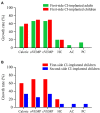Vestibular Function in Children and Adults Before and After Unilateral or Sequential Bilateral Cochlear Implantation
- PMID: 33995266
- PMCID: PMC8116579
- DOI: 10.3389/fneur.2021.675502
Vestibular Function in Children and Adults Before and After Unilateral or Sequential Bilateral Cochlear Implantation
Abstract
Background: Cochlear implantation (CI) helps patients with severe or profound sensorineural hearing loss (SNHL) restore hearing and speech abilities. However, some patients exhibit abnormal vestibular functions with symptoms such as dizziness or balance disorders, after CI. Whether age at CI and CI approach (unilateral or sequential bilateral) affect vestibular functions in users with cochlear implants remains unclear. Objectives: To investigate the vestibular functions in children and adults before and after unilateral or sequential bilateral CI. Materials and Methods: Thirty-seven patients with severe or profound SNHL who were candidates for a first- or second-side CI were divided into three groups: first-side CI-implanted adults (≥18 years), first-side CI-implanted children (6-17 years), and second-side CI-implanted children (6-17 years). All cases were implanted with the round window approach to minimize damage to the intra-cochlear structures. The caloric test, vestibular evoked myogenic potential (VEMP) test, video head impulse test (vHIT), Dizziness Handicap Inventory (DHI), Pediatric Vestibular Symptom Questionnaire (PVSQ), and audiometric tests were performed before and 1 month after CI. Results: The abnormal rates of caloric test and VEMP test after CI in the first-side CI-implanted adults and children significantly increased compared with those before CI. The pre-implantation VEMP test showed significantly higher abnormal rates between first- and second-side CI-implanted children. No other significant differences of abnormal rates between first- and second-side CI-implanted children or between first-side CI-implanted adults and children were found. In second-side CI-implanted children, PVSQ scores significantly increased at day 3 post-implantation but decreased at day 30. Conclusion: CI has a negative effect on the results of caloric and VEMP tests, but not on vHIT, indicating that the otolith and low-frequency semicircular canal (SCC) are more vulnerable to damage from CI. The alterations of vestibular functions resulting from CI surgery may be independent of age at CI and CI approach (unilateral or sequential bilateral). Long-term impacts on the vestibular function from CI surgery, as well as the chronic electrical stimulation to the cochlea, are still to be investigated.
Keywords: adults; children; cochlear implant; sequential bilateral implantation; unilateral implantation; vestibular function.
Copyright © 2021 Guan, Wang, Wu, Zhang, Sun, Guo and Sun.
Conflict of interest statement
The authors declare that the research was conducted in the absence of any commercial or financial relationships that could be construed as a potential conflict of interest.
Figures




References
LinkOut - more resources
Full Text Sources
Other Literature Sources
Research Materials

